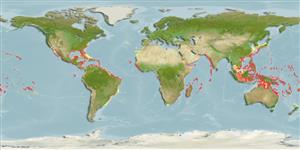Asteronema breviarticulatum (J. Agardh) Ouriques & Bouzon
| Native range | All suitable habitat | Point map | Year 2050 |

|
| This map was computer-generated and has not yet been reviewed. |
| Asteronema breviarticulatum AquaMaps Data sources: GBIF OBIS |
Upload your photos
Google image |
No photo available for this species.No drawings available for Scytothamnaceae.
Google image |
No photo available for this species.
Classification / Names Common names | Synonyms | CoL | ITIS | WoRMS
Phaeophyceae | Scytothamnales | Scytothamnaceae
Environment: milieu / climate zone / depth range / distribution range Ecology
Sessile. Tropical
Distribution Countries | FAO areas | Ecosystems | Occurrences | Introductions
Atlantic Ocean: In Cuba and Trinidad and Tobago, east to Cape Verde Island and south to Nigeria, including St. Helena and Ascension Island; Indian Ocean: In Kwazulu-Natal, South Africa; Pacific Ocean: In southern Viet Nam, Federated States of Micronesia and Papua New Guinea, east to Mexico, including Wake Atoll, American Samoa and Hawaiian Islands.
Length at first maturity / Size / Weight / Age
Maturity: Lm ? range ? - ? cmCommon length : 2.5 cm TL male/unsexed; (Ref. 82093)
Short description Morphology
Thalli, approximately 2.5 cm tall, form tufts of interwoven filaments, which have the appearance
of a frayed rope at its tips (Fig. 13). Filaments are uniseriate and irregularly branched with numerous short hooked branches arising at an angle of 80-90°. Growth takes place by intercalary cell divisions. Cells are 25-33 μm wide, 60-80 μm long, L/B: 1-1.3. Plurilocular sporangia, placed on a 1-2-celled stalk, are spherical to ovoid and measure 40 x 42 (-63) μm on average (Ref. 82093). It is characterised by the shape of the plurilocular sporangia and
the presence of short hooked branches (Ref. 82093).
Thalli, approximately 2.5 cm tall (Ref. 82093). Growing in the intertidal, often attached to barnacles in wave-exposed localities (Ref. 82093).
Life cycle and mating behavior Maturity | Reproduction | Spawning | Eggs | Fecundity | Larvae
Main reference
References | Coordinator | Collaborators
Guiry, M.D. and G.M. Guiry. 2009. (Ref. 80701)
IUCN Red List Status (Ref. 130435)
CITES status (Ref. 108899)
Not Evaluated
CMS (Ref. 116361)
Not Evaluated
Threat to humans
Human uses
| FishSource |
Tools
More information
Internet sources
BHL | BOLD Systems | CISTI | DiscoverLife | FAO(Publication : search) | Fishipedia | GenBank (genome, nucleotide) | GloBI | Gomexsi | Google Books | Google Scholar | Google | PubMed | AlgaeBase | Tree of Life | Wikipedia (Go, Search) | Zoological Record


